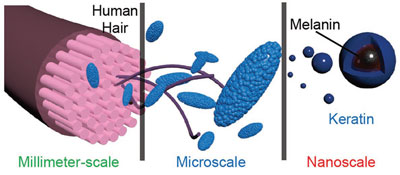| Posted: May 30, 2018 | |
Turning hair into a biomedical nanomaterial |
|
| (Nanowerk Spotlight) A key challenge in developing materials for biomedical engineering is their biocompatibility. Of course, it would be ideal if high-performance biomaterials could directly be obtained from patients themselves. | |
| This is exactly what a team of scientists in China has now demonstrated. They discovered that the hierarchical micro- and nanostructures of human hair can be turned into hierarchical micro- and nanoparticles with a simple top-down procedure and be used as a novel type of biomaterial for medical applications. | |
| This strategy of preparing biomaterials from abundant human hair might provide a potent tool for producing autogenous materials from patients themselves to overcome the drawbacks of synthetic materials. | |
| "This multifaceted material might provide a new tool for addressing biomedical challenges," Xian-Zheng Zhang, a professor in the Key Laboratory of Biomedical Polymers of Ministry of Education & Department of Chemistry at Wuhan University, tells Nanowerk. | |
| He and his team have published their findings in Advanced Materials ("Hierarchical Micro-/Nanostructures from Human Hair for Biomedical Applications"). | |
 |
|
| Schematic illustration of the hierarchical micro- and nanostructures from human hair. (Reprinted with permission by Wiley-VCH Verlag) | |
| "Our study began with a very interesting coincidence," Zhang recounts. "When we were preparing a sample for electron microscopy scanning, a piece of hair dropped on the object stage. Coincidentally, we observed the beautiful hierarchical structure in this piece of hair. Our major research interest is discovering new materials for solving biomedical problems, and materials obtained from the human body might be very suitable to address these challenges. Looking back at the whole research process, I think curiosity has motivated us to conduct this work." | |
| From a chemical perspective, hair is mainly composed of melanins and keratins – two polymers that are ideal materials for biomedical applications. Keratin-based biomaterials display superior performances in bone regeneration, hemostasis, and cell protection. Pigments of melanin, a kind of functional polymer existing in most life forms, have versatile functions in regulating redox equilibrium, photothermal conversion, and dynamic coloration. | |
| In their experiments the team found that, compared with commercialized carriers such as liposomes or albumin nanoparticles, the hair particles exhibited negligeable immunogenicity and intrinsic blood compatibility. | |
| "Due to the satisfactory photothermal conversion of melanin, both hair micro- and nanoparticles showed high and continuable photothermal conversion ability, and this feature made them ideal materials to achieve photothermal therapy," says Zhang. "Furthermore, these biomaterials displayed attentional abilities on light absorption and free radical scavenging. We also found that, when made into sunscreen, they could prevent skin from UV-induced damage. The aqueous dispersion of these particles could also relieve symptoms of cataracts, rescue mice from vein thrombosis, and suppress tumor growth." | |
| In their next research stage, the team will further investigate the bio-safety and durability of these materials. In the present study, all hair samples were used immediately after collection. However, translating an eventual hair-based hierarchical biomaterial from conceptional work into clinical applications, exploring and optimizing the standard conditions of hair collection, transportation and storage would be an inevitable step. | |
| "Advances in medicine in the areas of genomics, proteomics, tissue engineering, and regenerative medicine are occurring at a rate that was previously unthinkable," Zhang concludes. "The purpose of our research is to discover high-performance biomaterials through interdisciplinary methods and help facilitate their successful introduction into clinical applications." | |
 By
Michael
Berger
– Michael is author of three books by the Royal Society of Chemistry:
Nano-Society: Pushing the Boundaries of Technology,
Nanotechnology: The Future is Tiny, and
Nanoengineering: The Skills and Tools Making Technology Invisible
Copyright ©
Nanowerk LLC
By
Michael
Berger
– Michael is author of three books by the Royal Society of Chemistry:
Nano-Society: Pushing the Boundaries of Technology,
Nanotechnology: The Future is Tiny, and
Nanoengineering: The Skills and Tools Making Technology Invisible
Copyright ©
Nanowerk LLC
|
|
|
Become a Spotlight guest author! Join our large and growing group of guest contributors. Have you just published a scientific paper or have other exciting developments to share with the nanotechnology community? Here is how to publish on nanowerk.com. |
|
